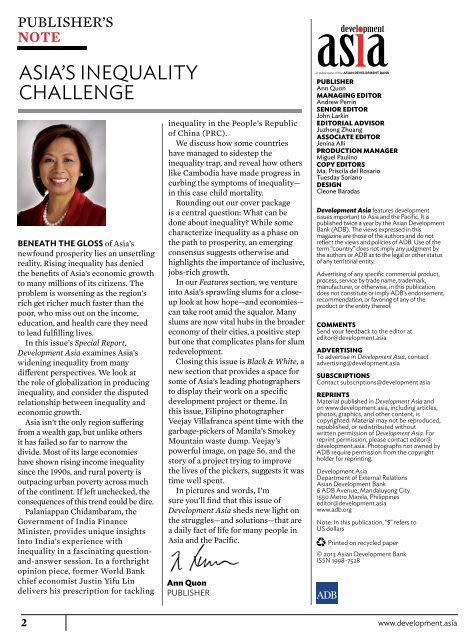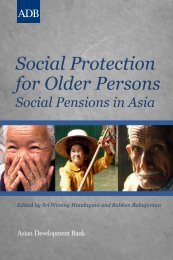DEEPENING
DEEPENING
DEEPENING
You also want an ePaper? Increase the reach of your titles
YUMPU automatically turns print PDFs into web optimized ePapers that Google loves.
PUBLISHER’S<br />
NOTE<br />
ASIA’S INEQUALITY<br />
CHALLENGE<br />
BENEATH THE GLOSS of Asia’s<br />
newfound prosperity lies an unsettling<br />
reality. Rising inequality has denied<br />
the benefi ts of Asia’s economic growth<br />
to many millions of its citizens. The<br />
problem is worsening as the region’s<br />
rich get richer much faster than the<br />
poor, who miss out on the income,<br />
education, and health care they need<br />
to lead fulfi lling lives.<br />
In this issue’s Special Report,<br />
Development Asia examines Asia’s<br />
widening inequality from many<br />
diff erent perspectives. We look at<br />
the role of globalization in producing<br />
inequality, and consider the disputed<br />
relationship between inequality and<br />
economic growth.<br />
Asia isn’t the only region suff ering<br />
from a wealth gap, but unlike others<br />
it has failed so far to narrow the<br />
divide. Most of its large economies<br />
have shown rising income inequality<br />
since the 1990s, and rural poverty is<br />
outpacing urban poverty across much<br />
of the continent. If left unchecked, the<br />
consequences of this trend could be dire.<br />
Palaniappan Chidambaram, the<br />
Government of India Finance<br />
Minister, provides unique insights<br />
into India’s experience with<br />
inequality in a fascinating questionand-answer<br />
session. In a forthright<br />
opinion piece, former World Bank<br />
chief economist Justin Yifu Lin<br />
delivers his prescription for tackling<br />
inequality in the People’s Republic<br />
of China (PRC).<br />
We discuss how some countries<br />
have managed to sidestep the<br />
inequality trap, and reveal how others<br />
like Cambodia have made progress in<br />
curbing the symptoms of inequality—<br />
in this case child mortality.<br />
Rounding out our cover package<br />
is a central question: What can be<br />
done about inequality? While some<br />
characterize inequality as a phase on<br />
the path to prosperity, an emerging<br />
consensus suggests otherwise and<br />
highlights the importance of inclusive,<br />
jobs-rich growth.<br />
In our Features section, we venture<br />
into Asia’s sprawling slums for a closeup<br />
look at how hope—and economies—<br />
can take root amid the squalor. Many<br />
slums are now vital hubs in the broader<br />
economy of their cities, a positive step<br />
but one that complicates plans for slum<br />
redevelopment.<br />
Closing this issue is Black & White, a<br />
new section that provides a space for<br />
some of Asia’s leading photographers<br />
to display their work on a specifi c<br />
development project or theme. In<br />
this issue, Filipino photographer<br />
Veejay Villafranca spent time with the<br />
garbage-pickers of Manila’s Smokey<br />
Mountain waste dump. Veejay’s<br />
powerful image, on page 56, and the<br />
story of a project trying to improve<br />
the lives of the pickers, suggests it was<br />
time well spent.<br />
In pictures and words, I’m<br />
sure you’ll fi nd that this issue of<br />
Development Asia sheds new light on<br />
the struggles—and solutions—that are<br />
a daily fact of life for many people in<br />
Asia and the Pacifi c.<br />
Ann Quon<br />
PUBLISHER<br />
A publication of the ASIAN DEVELOPMENT BANK<br />
PUBLISHER<br />
Ann Quon<br />
MANAGING EDITOR<br />
Andrew Perrin<br />
SENIOR EDITOR<br />
John Larkin<br />
EDITORIAL ADVISOR<br />
Juzhong Zhuang<br />
ASSOCIATE EDITOR<br />
Jenina Alli<br />
PRODUCTION MANAGER<br />
Miguel Paulino<br />
COPY EDITORS<br />
Ma. Priscila del Rosario<br />
Tuesday Soriano<br />
DESIGN<br />
Cleone Baradas<br />
Development Asia features development<br />
issues important to Asia and the Pacifi c. It is<br />
published twice a year by the Asian Development<br />
Bank (ADB). The views expressed in this<br />
magazine are those of the authors and do not<br />
refl ect the views and policies of ADB. Use of the<br />
term “country” does not imply any judgment by<br />
the authors or ADB as to the legal or other status<br />
of any territorial entity.<br />
Advertising of any specifi c commercial product,<br />
process, service by trade name, trademark,<br />
manufacturer, or otherwise, in this publication<br />
does not constitute or imply ADB’s endorsement,<br />
recommendation, or favoring of any of the<br />
product or the entity thereof.<br />
COMMENTS<br />
Send your feedback to the editor at<br />
editor@development.asia<br />
ADVERTISING<br />
To advertise in Development Asia, contact<br />
advertising@development.asia<br />
SUBSCRIPTIONS<br />
Contact subscriptions@development.asia<br />
REPRINTS<br />
Material published in Development Asia and<br />
on www.development.asia, including articles,<br />
photos, graphics, and other content, is<br />
copyrighted. Material may not be reproduced,<br />
republished, or redistributed without<br />
written permission of Development Asia. For<br />
reprint permission, please contact editor@<br />
development.asia. Photographs not owned by<br />
ADB require permission from the copyright<br />
holder for reprinting.<br />
Development Asia<br />
Department of External Relations<br />
Asian Development Bank<br />
6 ADB Avenue, Mandaluyong City<br />
1550 Metro Manila, Philippines<br />
editor@development.asia<br />
www.adb.org<br />
Note: In this publication, "$" refers to<br />
US dollars<br />
Printed on recycled paper<br />
© 2013 Asian Development Bank<br />
ISSN 1998-7528<br />
2 www.development.asia




